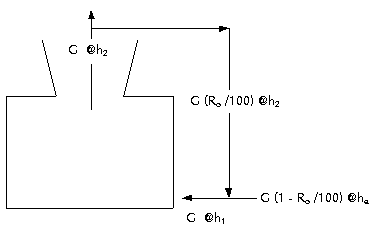|
Many works had been studied by several institutes, but
the study by CTI is most acceptable for the tower designs.
The recirculation in the cooling towers is defined as
an adulteration of the atmosphere entering the tower
by a portion of the atmosphere leaving the tower. This
adulteration by the exhaust air raises the wet bulb
temperature of the entering air above that of the ambient
air, reducing the tower overall performance.
The recirculation phenomenon
arises primarily because of the negative pressure produced
on the leeward side of the cooling tower by the wind
blowing across the structure. Thus, any factors which
enhances this lee-side negative pressure will increase
recirculation. At the same time, those elements of tower
design or meteorological phenomena which increase the
amount of ambient air which mixes with the exhaust air
before entering the lee-side air inlets will reduce
the magnitude of recirculation. Recirculation is therefore
a complex result of factors which affect the lee-side
negative pressure and the amount of exhaust air dilution.
From the mathematical standpoint
recirculation can be expressed as the percent of the
exhaust air which reenters the tower at the air inlets.
Thus, considering a heat balance on the air around the
tower:
Heat (Q) = G h1
= G (1 - Rc/100) ha + G (Rc
/100) h2
This equation could be written
as below:
G h1 = G ha
- G Rc ha / 100 + G Rc
h2 / 100
G (h1 - ha) = G Rc
/100 (h2 - ha)
Solving for Rc,
Rc = (h1 - ha) / (h2
- ha) x 100
| From
the equation of h2 = h1 + L/G Range,
the enthalpy difference between h1
and ha can be obtained as follows;
(h1 - ha)
100 = Rc (h1 + L/G Range
- ha)= Rc h1
+ Rc L/G Range - Rc ha
= Rc (h1 - ha)
+ Rc L/G Range
(h1 - ha)
100 ( 1 - Rc) = Rc L/G Range
Solving for (h1
- ha), (h1 - ha) = Rc
L/G Range / ( 1 - Rc) 100
|

|
|